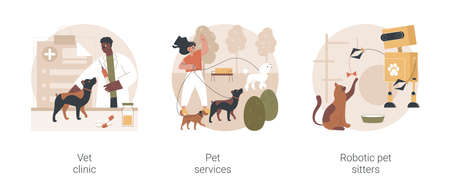Understanding Noise Sensitivity in Small Pets
When it comes to creating a comfortable home for small pets, managing noise levels is a crucial factor that often gets overlooked. Species like rabbits, guinea pigs, and hamsters have highly sensitive hearing, far more acute than what humans experience daily. These animals rely on their sense of hearing not only to communicate but also as an early warning system against potential threats in the wild. In a typical American household, everyday sounds—such as televisions, vacuum cleaners, loud music, or even the hustle and bustle of kids playing—can be overwhelming for these tiny companions. Excessive or unpredictable noise can trigger stress responses, leading to behavioral changes like hiding, reduced appetite, or increased aggression. Understanding how these pets perceive sound helps us appreciate why it’s important to provide them with quieter spaces and routines that minimize sudden loud noises. By tuning into their unique needs, pet owners can foster a more peaceful and healthy environment for their furry friends.
2. Common Household Noise Sources
When managing noise levels for small pets, it’s important to recognize the typical sources of sound in American homes that can impact their well-being. Everyday life comes with a variety of noises—some obvious, others more subtle—that might stress or disturb animals like rabbits, guinea pigs, hamsters, and birds. Understanding these sources is the first step toward creating a calmer environment.
Major Noise Contributors in the Home
Most household noise comes from a blend of appliances, entertainment systems, human activity, and even external factors such as traffic. Each source can produce sounds at different frequencies and intensities, which may be more noticeable or stressful to small pets than to people. Here’s a breakdown of common noise sources:
| Noise Source | Examples | Potential Impact on Pets |
|---|---|---|
| Appliances | Washing machines, vacuum cleaners, dishwashers, refrigerators | Loud cycles or sudden starts/stops can startle pets or cause ongoing stress |
| Entertainment Systems | TVs, stereos, gaming consoles, home theaters | High volume or bass vibrations may disrupt rest and trigger anxiety |
| Human Activity | Loud conversations, parties, children playing, door slamming | Irregular or unpredictable noises are especially unsettling for sensitive animals |
| Traffic & Outdoor Noise | Cars passing by, emergency sirens, construction work, lawn mowers | Distant but persistent sounds can create a constant background stressor |
| Pets Themselves | Barking dogs, chirping birds in the same or neighboring homes | Noises from other animals can provoke defensive behavior or distress |
Recognizing Patterns Is Key
The impact of these noise sources depends on their frequency, duration, and timing. For example, a single loud bang may scare a pet temporarily, but repeated exposure to high-volume TV shows or frequent vacuuming near their enclosure can cause chronic stress. By identifying patterns and major contributors within your living space, you’re better equipped to make changes that support your pet’s comfort.

3. Signs Your Small Pet Is Stressed by Noise
Recognizing when your small pet is overwhelmed by noise is crucial for their well-being. While every animal reacts differently, there are several common behaviors and physical cues that signal stress from a loud environment. Here’s what to look out for:
Observable Behavioral Changes
- Hiding or Retreating: If your pet suddenly seeks shelter in corners, under bedding, or inside hideouts more than usual, it may be trying to escape overwhelming sounds.
- Restlessness: Pacing, running in circles, or constant movement can indicate anxiety caused by unfamiliar or loud noises.
- Aggression or Irritability: Some pets might nip, bite, or show defensive behaviors when they’re feeling threatened by their environment.
Physical Signals of Stress
- Trembling or Shaking: Noticeable body tremors or shivering, especially during sudden bursts of noise, are strong indicators of distress.
- Excessive Grooming: Over-grooming or fur-plucking can be a coping mechanism for stress in species like rabbits and guinea pigs.
- Changes in Appetite: A sudden loss of interest in food or water may be linked to environmental discomfort from noise.
Lesser-Known Stress Responses
- Flattened Posture: Many small pets will press their bodies low to the ground as an instinctive response to perceived threats.
- Vocalizations: Increased squeaking, chirping, or other vocal sounds can be a plea for help or a reaction to stress.
Why Paying Attention Matters
If you observe these signs consistently when noise levels rise, it’s time to take action. Early intervention not only helps reduce your pet’s anxiety but also prevents potential health issues related to chronic stress. In the next section, we’ll explore practical steps you can take to create a calmer environment for your small companion.
4. Strategies for Reducing Noise in Pet Areas
If you’re noticing that your small pets seem stressed or agitated, noise might be the culprit. Fortunately, there are several practical strategies to help minimize sound exposure and create a more peaceful environment for your furry friends. Let’s break down some proven approaches to managing noise levels in your pet spaces.
Smart Layout Changes
One of the simplest ways to reduce noise is by rethinking the layout of your pet area. Place cages or enclosures away from high-traffic zones like kitchens, entryways, or living rooms where loud conversations and TV noise are common. If possible, choose a room with carpeting, curtains, or upholstered furniture—these soft materials naturally absorb sound and can make a big difference.
Soundproofing Materials
Investing in some basic soundproofing can help shield your pets from disruptive noises. Here’s a quick comparison of popular options:
| Material | Where to Use | Benefits |
|---|---|---|
| Foam Panels | On walls near cages | Absorbs echoes and reduces sharp sounds |
| Heavy Curtains | Over windows or doorways | Blocks outside street noise and muffles indoor sound |
| Rugs or Carpets | Under enclosures/cages | Dampens vibrations from movement and foot traffic |
Relocating Cages or Enclosures
If you have flexibility with your space, consider moving your pet’s home to a quieter part of the house. Basements (if dry and well-ventilated) or spare bedrooms can be ideal since they tend to be farther from daily commotion. Just remember to avoid areas with temperature extremes or poor air flow.
Additional Practical Tips
- Add white noise machines or gentle background music to mask sudden sounds.
- Avoid placing cages directly on hard floors; use a towel or mat underneath for extra cushioning.
- If you live in an apartment, talk with neighbors about quiet hours—sometimes a simple conversation goes a long way.
The Bottom Line
Managing noise in small pet environments doesn’t have to be complicated or expensive. With a few thoughtful adjustments—like rearranging furniture, installing soft materials, and choosing the right location—you can make life calmer for both you and your pets.
5. Integrating Quiet Time into Daily Routines
American life can be fast-paced and noisy, but our small pets thrive when we intentionally carve out moments of calm each day. Scheduled quiet periods provide many benefits for pets, including reduced stress, better sleep quality, and a sense of security within their environment. These quiet breaks are especially important for animals like rabbits, guinea pigs, birds, and hamsters, who are sensitive to constant noise and commotion.
Benefits of Scheduled Quiet Periods
Giving your pet regular downtime helps prevent overstimulation and anxiety-related behaviors such as hiding, excessive chewing, or aggression. Just as humans need peaceful moments to recharge, pets also need time away from the hustle and bustle. Quiet periods allow them to rest deeply, which supports their physical health and emotional well-being.
Making Quiet Time Work in a Busy American Lifestyle
Integrating quiet time into your daily schedule doesn’t have to be complicated. Start by observing when your household is naturally less active—perhaps early in the morning before work or school, or in the evening after dinner. Use these windows to dim the lights near your pet’s enclosure, lower the volume on TVs and music players, and encourage family members to speak softly around your furry or feathered friends.
Practical Tips for Consistent Quiet Time
– Set a reminder on your phone for dedicated “pet quiet hour” each day.
– Place your pet’s habitat in a part of the home that’s less trafficked during busy times.
– Use white noise machines or soft background music designed for pets to mask unpredictable household sounds.
– Explain the importance of quiet time to children so they can help maintain a peaceful environment.
– If you’re frequently away from home, consider automated timers for lights and sound to simulate a calm routine even when you’re not there.
By making scheduled quiet periods a non-negotiable part of your pet care routine, you’re not just managing noise—you’re investing in your small companion’s overall happiness and long-term health.
6. When To Seek Expert Help
Even with the best efforts to manage noise levels in your small pet’s environment, sometimes you may notice ongoing signs of stress or anxiety. If your pet continues to show symptoms like hiding, excessive grooming, loss of appetite, or aggressive behaviors despite your interventions, it might be time to seek expert help. Persistent noise sensitivity can indicate deeper issues that require professional guidance.
Recognizing Persistent Noise Sensitivity
If you’ve already tried common solutions—like rearranging your pet’s living space, adding soundproofing materials, and maintaining a consistent routine—but your pet still seems distressed by everyday household sounds, don’t ignore these warning signs. Chronic stress from noise can negatively impact both mental and physical health over time.
When to Contact a Veterinarian
A veterinarian should be your first point of contact if you notice sudden changes in your pet’s behavior or health. Sometimes, what looks like noise aversion might be related to pain, illness, or age-related issues such as hearing loss. A vet can rule out medical causes and provide recommendations tailored to your pet’s specific needs.
Consulting a Pet Behaviorist
If medical causes are ruled out but the noise sensitivity persists, consulting a certified animal behaviorist is the next step. These professionals specialize in animal psychology and can offer customized training plans or desensitization techniques designed for small pets. They’ll work closely with you to identify triggers and develop strategies for gradual adaptation to unavoidable noises.
Don’t Wait Too Long
It’s always better to reach out sooner rather than later if you’re concerned about your pet’s wellbeing. Early intervention can prevent long-term anxiety and help create a more peaceful home environment for both you and your furry companion. Remember, every pet is unique—sometimes getting an expert involved is the key to finding the right solution.


